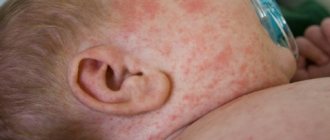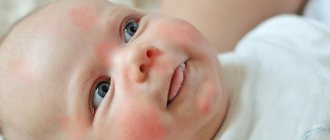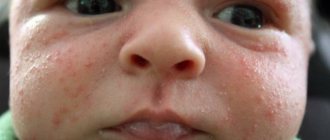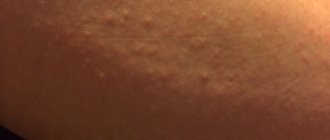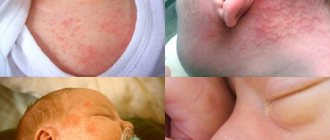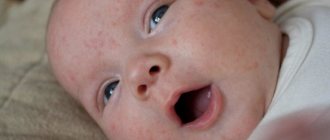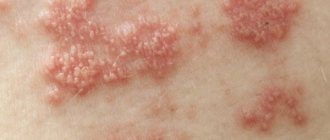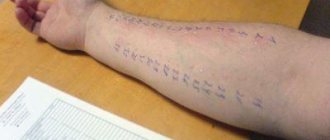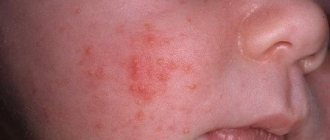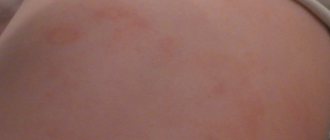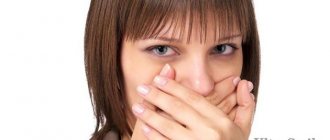From the first day of birth, the body's immune system is formed. Any external symptoms can signal serious pathologies, as well as be a banal manifestation of the influence of external factors. You shouldn't ignore them. Any rash, redness, or irritation should alert you; in such cases, the main thing is to consult a doctor and examine the baby’s body.
Rash in newborns: causes of appearance
Pimples in a newborn are divided into four main groups:
- Formation of stable hormonal levels in the baby. In this case, the rash in a baby is physiological in nature. It does not require treatment and goes away on its own after hormonal levels stabilize.
- Allergic reaction. May occur on products consumed by a nursing mother, children's cosmetics, clothing, and medications.
- Errors in child care. Allowing excess moisture on the skin leads to heat rash.
- Infectious diseases.
The rash in newborns can be in the form of blisters, pustules, white or red bumps
How and with what can you treat white pimples on a baby’s face?
Very often, inexperienced parents, having noticed white rashes on the baby’s face, begin to look for all sorts of ways to eliminate them and at the same time make common mistakes.
It should be remembered that small pimples with a white head are a temporary phenomenon and they will disappear on their own in two to three months, as soon as all the newborn’s systems, including the hormonal one, begin to function normally.
You can add potassium permanganate to your baby's bathing water.
What you can do:
- several times a day, it is advisable to wipe the baby’s face and body with a sterile swab dipped in cool boiled water;
- parents can independently make a weak decoction of chamomile or string , moisten a napkin in this infusion and wipe the affected areas;
- a few granules of potassium permanganate or a third of a teaspoon of starch to the bath water .
What not to do:
- antibacterial lotions and ointments to wipe the child’s face
- lubricate the rash with iodine, brilliant green or fucorcin , these products dry out the skin, which can lead to peeling;
- absolutely not squeeze pus out of pimples , as you can not only get an infection, but also damage the baby’s delicate skin, which will leave unattractive scars on his face forever.
White pimples on a newborn’s face do not require special treatment; after a few months, his skin will become clean and smooth, and parents should simply be patient and not take measures that often only harm the baby.
Acne
Also in science it has the name neonatal childhood pustulosis. It consists of red or white pimples on the face of a newborn without pustules. They are located mainly on the baby’s forehead and cheeks and do not cause discomfort. This is a natural physiological process through which the baby adapts to life outside the mother’s body. There is a release of accumulated hormones that lead to the appearance of such a rash. Treatment in this case is not required; by the age of three months, such rashes go away on their own. The only requirement is to cleanse the baby's skin with boiled water or herbal decoction.
Causes of white pimples on a baby's face
Most newborns have tiny white bumps that look like beads and can appear on their face in the first days of their life.
Acne on a baby's face is temporary and parents should not panic.
This common phenomenon is due to the fact that maternal hormones still remain in the baby’s body , which will be completely eliminated only after a few months. Doctors call such pimples “hormonal acne” and, according to their recommendations, parents should not panic and look for treatment methods. As a rule, a small rash on a baby’s face is a temporary phenomenon and as soon as all metabolic processes in the newborn’s body return to normal, the problem will disappear.
Immaturity of the sebaceous glands
Another reason for the appearance of small pimples in infants lies in the immaturity of the sebaceous glands . Such pimples appear on the face, less often on the body of newborns in the second or third week of their life and are called milia . Naturally, young parents are worried about a semolina-like rash on the baby’s nose, forehead and cheeks, but there is no reason to worry when the baby’s sebaceous glands normalize, his skin will become clean and smooth.
If the pimples are not inflamed, do not itch, do not discharge pus, and do not cause visible discomfort to the child, then there is no need for drug treatment. But, if parents notice that the rash on the baby’s face has acquired an unhealthy red color and is accompanied by itching , they should seek help from a pediatrician.
If the rash turns red, you should contact your pediatrician.
Under no circumstances should you try to eliminate the problem yourself with pharmaceutical ointments or lotions for the treatment of acne, since the child may be allergic to some components of the medications.
Food allergies
This rash on the face of a baby is usually caused by improper nutrition of the nursing mother. During breastfeeding, a woman must adhere to certain dietary rules and eat hypoallergenic foods, especially in the first months of the baby's life. Formula-fed babies may be allergic to formula components. In this case, it is recommended to replace the mixture with an alternative hypoallergenic one. The transition must be gradual; with a sudden change in baby food, allergic reactions may intensify.
Allergic reactions
Sometimes the cause of a rash on a child's body is an allergy. It appears in the form of red spots with a small rash, sometimes flaky crusts are present. It is localized mainly on the head, behind the ears, and on the chin. What can cause allergic acne in a newborn? Here are the most common ones:
We recommend reading: How to treat heat rash in a newborn
- poor nutrition of a nursing mother, the presence of allergens in her diet (honey, sweets, red berries, etc.);
- unsuitable formula;
- the baby’s reaction to detergents that are used to wash his clothes, as well as to other care products;
- pet hair;
- dust in the baby's room.
The initial form of allergy is called diathesis. This is not a disease, but a reaction of the immune system to irritants. At this stage, it is very important to identify the factor causing the rash. It is problematic to do this on your own; it is better to seek the help of an allergist. After this, it is necessary to protect the baby from the identified irritant.
An experienced doctor will recommend how to treat allergic pimples in newborns and, if necessary, prescribe antihistamines. Among the folk methods, the most popular are bathing in herbal decoctions: string, chamomile, oregano, oak bark. It is very important to choose natural products for caring for the baby, balance the mother’s diet, do wet cleaning in the apartment more often, and choose a hypoallergenic formula when artificial feeding.
Contact allergy
This type of allergy is much more common. If the baby's skin comes into contact with fabric or dishes, rashes may occur. Such pimples in a newborn may appear from a reaction to synthetic fabric, incorrectly selected washing powder or children's cosmetics. The baby's skin is extremely susceptible to chemicals and unnatural materials. Therefore, pediatricians recommend using exclusively children's care products: dishwashing liquids, washing powders and rinse aids. They contain hypoallergenic components and a minimal amount of fragrances compared to conventional products. They should be used during the baby's first year, and if he is prone to allergies, up to three years.
Diaper dermatitis
Inflamed skin in the diaper area is called diaper dermatitis. Its signs are redness of the skin, peeling and the appearance of small blisters. The disease manifests itself due to high humidity and constant contact of the skin with wet laundry. It is pointless to treat dermatitis with antihistamines. To solve the problem, you need to avoid contact of the skin with a damp environment as much as possible (timely change of the diaper). To heal the skin, there are ointments with an antiseptic effect that are ideal for young children: Bepanten, Drapolen, D-panthenol, Boro Plus.
A humid environment promotes the development of bacterial infection. If deep wounds appear, you need to be examined by a dermatologist, as a fungal infection may form, which can be treated with drugs that have a fungicidal effect.
Prickly heat
Small pink and red rash in newborns. They can appear on different parts of the child's body. Most often, pimples appear on the face of a baby, closer to the scalp. They are caused by an immature sweating system. The thermoregulation of a small organism is still imperfect, sweating occurs in large volumes, and the sweat ducts cannot remove such an amount of moisture. The result is skin rashes.
To get rid of prickly heat, you need to regularly carry out hygiene procedures and dress your child correctly in accordance with the weather. Newborns tolerate cold more easily than heat. Therefore, you should not wrap your child up, especially in the summer.
Why do acne appear?
Blistering, rash-like, single pimples can occur for various reasons. Pediatricians identify the main ones, which include:
- Dental. When teething, the baby may develop pimples on the face, mainly near the mouth. They occur due to excessive salivation. As soon as the teeth erupt, the skin dries out and they disappear.
- Allergy. Here it is worth paying attention to the color. Red, small or large pimples may appear as an allergic response to food, detergents, or laundry detergents. A nursing mother should be more selective in food - red vegetables, fruits, citrus fruits, eggs, milk can cause rashes in the baby. A complete map of the diet of mother and child is studied. Symptoms will go away immediately as soon as allergenic foods, chemicals, etc. are eliminated.
- Infantile miliaria (prickly heat). Overheating of the body of a newborn baby and excessive wrapping leads to an imbalance in thermal balance. Children's heat rash goes away with the right approach to hygiene and optimal temperature conditions.
- Poor hygiene. Acne occurs when hygiene rules are violated. Regular bathing, body treatment with special creams, and air baths are recommended. In advanced cases, infection is possible.
- Graft. In rare cases, rashes may appear after vaccination; in such cases, you should immediately consult your doctor.
- Overheating, hypothermia. The skin of a newborn is very sensitive; any violation of the temperature regime, be it hypothermia, prolonged exposure to cold air, strong wind or sun, causes a reaction in the baby’s skin. To eliminate the problem, it is necessary to limit the time spent in unfavorable conditions and treat the body with special protective creams.
- Reaction to a bite. If you notice that unevenly spaced red spots, swelling, and pimples have appeared on your body, it means that it could have been bitten by insects. To avoid this, it is necessary to use repellents, otherwise the bite can lead to a severe allergic response, including swelling of the respiratory tract and the development of serious diseases of the internal organs. Insect bites often lead to infection with parasitic larvae.
It is strictly forbidden to use poisons to kill fleas, ticks, and bedbugs. You will have to pay more attention to hygiene, wash linen and bedding thoroughly, treat the room with natural detergents, use herbs - wormwood, nettle.
- Staphylococcus, streptococcus. Both small and large pimples and ulcers may appear on the child’s body. The disease manifests itself in different parts of the body and involves internal organs in the inflammatory process. It is necessary to urgently consult a doctor and undergo a complete examination of the body with further treatment.
- Infectious diseases - measles, chickenpox, rubella and others. The rash is a consequence of these pathologies and may be accompanied by high fever, headaches, weakness and goes away after complete recovery.
- Intestinal disease of infants - dysbacteriosis. Disruption of the microflora in the intestines of a newborn is accompanied by external manifestations in the infant - acne, rash, redness of the skin, peeling on the scalp.
- Diabetes. The first signs of diabetes are redness and a rash on the child’s bottom and genitals. The symptom occurs due to elevated blood sugar levels.
- Sexual development. During puberty, the hormonal background is formed and changes occur, as a result of which age-related acne, acne, ulcers, and blackheads may appear. Location: face, neck, décolleté, temples and even scalp. Mature pimples must be treated with antiseptic gels. The problem may go away after the end of puberty with proper hygiene, treatment with special creams, and drug therapy.
- Reaction to drugs. When a nursing mother uses steroid drugs, products with phenytoin, or lithium, the baby may develop acneiform acne. If you stop taking the medications, they will disappear in no time.
- Herpes. Small blistering pimples form on the face around the mouth, the gums swell, and are accompanied by pain when touched.
- Eczema. This pathology most often affects young children. The cause of the disease has not yet been determined. The rash is accompanied by dry skin, peeling, and cracking.
- Scabies. Pimples appear on the child's body, mainly in the abdomen, on the elbows, between the fingers, toes, and on the wrists, accompanied by severe itching, especially in the evening when covered with a blanket.
Baby acne
In the first six months of life, 20% of infants develop a rash, which is called “newborn baby acne.” White pustules are localized in one area or cover the entire body, including the head. They can be in the form of papules or pustules, white and yellow. There is no exact data about the reason for their appearance, there is only an assumption that this is the result:
- excess hormones transmitted through the mother’s body during intrauterine development;
- excessive production of sebaceous glands;
- formation of the newborn’s own hormonal system;
- blockage of hair follicles.
Infections
Very often, a rash in newborns is an accompaniment of some infectious disease. In addition to the face, it is localized on other parts of the body, according to the disease. In all cases of infection, the rashes are accompanied by elevated body temperature and a painful condition of the baby.
- Measles. The rash is bright red and large. Appears on the 4th-5th day of the disease. It primarily occurs on the face and in the ear area, then spreads to the entire body.
- Roseola. Red-pink rashes appear three days after infection.
- Chicken pox. The rash appears immediately along with an increase in temperature. Red watery spots all over the body.
- Rubella. Small pinkish pimples on a newborn. They appear on the face and spread to the limbs and torso.
- Scarlet fever. The scarlet fever rash begins in the neck area, gradually spreading to the back, chest, and then the whole body. It is scarlet in color and has a dotted character. If the rash appears on the face, it will not affect the nasolabial part. This is a characteristic feature of the disease.
Types of acne in children
To determine what disease a pimple signals, it is necessary to study their types.
- Watery, red pimples are a symptom of chickenpox. It starts with one or two pimples, then spreads throughout the body.
- Pale, white, pink, red, appearing on the face in the area of the baby’s chin, merging into one large spot - profuse drooling, teething.
- A rash on the baby's bottom - prickly heat, diaper rash due to wearing a diaper for a long time.
- Rash on the arms (palms), feet in the spring and autumn – dyshidrosis.
- A white pimple with a black dot in the center is molluscum contagiosum.
- A pimple that appears against the background of a red spot, rapidly degenerating into a water bubble - streptoderma.
- A small rash on the body of a newborn is a lack of fresh air, poor ventilation of the room, excessive wrapping.
Detection of any type of pimples requires medical intervention. The child’s body is fragile and symptoms may indicate other diseases. Self-medication is strictly prohibited.
Treatment of rashes in babies
First, you need to determine the cause of the baby's rash. If the causes are physiological, then the rash in newborns does not need to be treated. It is enough to bathe your baby every day and do not neglect hygiene procedures. If the cause is an allergic reaction of the body, remove the allergen from the diet of mother and child or change the mixture. It may be necessary to change baby care products and clothes.
When prickly heat appears, the child should be dressed according to weather conditions and avoid overheating. It will be enough to put one more layer of clothing on your child than on yourself. Give your baby air baths. When bathing, it is recommended to add decoctions of herbs or chamomile to the water. They have a beneficial effect on the skin, reducing rashes and itching. After bathing, dry problem areas using special means.
Infectious diseases are treated only by qualified doctors. At the first signs of illness, you need to call a specialist to your home.
During treatment, you need to maintain the cleanliness of things and toys that the baby comes into contact with as much as possible. It is recommended to change bed linen every day, and iron it thoroughly and on both sides. The following steps can also be used to eliminate the rash and relieve symptoms:
- bathing a child in a weak solution of potassium permanganate or herbal infusions:
- wiping problem areas with boiled water or herbal decoction three to four times a day;
- regular cleaning of the nursery and ventilation of the room in the absence of the child;
- Do not go for walks with your baby in crowded places, as his immune system is weakened.
Following these recommendations and timely seeking medical help will help you overcome the disease in a short time.
If you have a rash, you should not use colored drying antiseptics: brilliant green, potassium permanganate, fucorcin. It is prohibited to use any products that contain alcohol, as they can burn the child’s already inflamed skin. Any medicinal oils, ointments (especially hormonal ones!), creams, calendula decoction, powder can harm the baby. Taking lactic acid bacteria and sorbents like Smecta is useless. Antibiotics and drugs used during allergies should not be given to the child, they do not help.
Squeezing pimples is strictly prohibited!
What to do to prevent acne in newborns
When visiting a doctor, he will definitely ask parents questions:
- What type of powder is used for washing children's clothes;
- How is hygiene maintained?
- What does a nursing mother eat?
- What does the baby eat?
- How baby feeding and drinking bottles and baby dishes are processed;
- Does the child play with toys of dubious manufacture, chemically colored, or made from allergenic material?
High-quality children's goods stores do not sell goods of dubious origin; they must be marked “for children.”
With proper hygiene, a normal diet including natural types of non-allergic foods, and strict adherence to the doctor’s recommendations, there will be no problems with the baby’s skin. A healthy lifestyle - frequent exposure to fresh air, an optimal amount of fluid intake per day, air baths will not give a chance of not only acne, but also problems with the child’s health.
